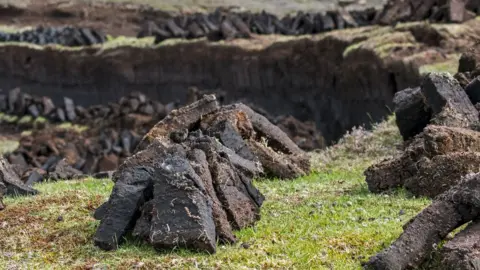'Restore UK bogs' to tackle climate change
 Getty Images
Getty ImagesRestoring peat moors degraded by farming may prove a relatively inexpensive way of tackling climate change, a report shows.
Wet peat bogs store carbon that’s been sucked from the air by plants, but many bogs have been drained for farming.
As drained peat dries, CO2 is produced - so in that sense peat’s causing a climate problem like cars, planes and factories.
But statisticians say parts of the peat problem may be relatively cheap and easy to solve.
They say the benefit of blocking up drainage ditches and bringing back vegetation to the moors shows benefits way higher than the cost.
Who has done the numbers?
The sums have been done by the Office for National Statistics (ONS), which reports to Parliament.
It estimates that fully restoring the UK’s lost peatlands could cost between £8-22bn over the next 100 years.
But this is dwarfed by the predicted savings of £109bn in terms of reduced carbon emissions.
Adam Dutton, head of natural capital for ONS, told BBC News: “There are many uncertainties and variations in ways of restoring peat so our number are very coarse.
“But there’s a very large difference between costs and benefits, so there may be policy implications.
Peatlands occupy around 12% of the UK's land area and provide over a quarter of the country's drinking water. They are a much-loved tourist destination, and rich in wildlife.
Were people surprised by emissions from peat?
A recent assessment of greenhouse gas emissions from peatlands was done by Prof Chris Evans, from the Centre for Ecology and Hydrology.
He estimated annual UK peat-related emissions in the UK of about 15-20 megatonnes of CO2 equivalent (out of 380 megatonnes for the entire economy).
“This surprised a lot of people,” Prof Evans told us. “It’s fair to say peat has been under-played as an issue – but it’s not now.
“It’s pretty clear peat is a sizeable emissions source and if we want to achieve Net Zero carbon emissions (in the UK) we will have to address it.”
Peatlands include both the highest and lowest value agricultural lands in the country, the report says.
Which peatlands in the UK generate most CO2?
Agriculture on lowland peats, mainly in the east of England, include areas of high crop value – but there has been massive loss of soil through drainage and ploughing.
At the other end of the farming spectrum, upland peat is used for low-value livestock that only make a profit with subsidy.
But here's a snag: Prof Evans said around half of the potential emission savings are in the 10-20% of peat area under lowland agriculture.
 Getty Images
Getty ImagesHe added: “This is the most intractable part because it is also the most profitable, and most expensive to restore in terms of practical challenges and the loss of agricultural income.
I understand the Department for Environment, Food and Rural Affairs (Defra) is striving to develop strategies over lowland peat.
The Committee on Climate Change told BBC News that the upfront costs of peat restoration can vary significantly due to the level of degradation encountered, the restoration technique used and accessibility of the site.
Using helicopters to transport material, for instance, would be expensive.
Is restoring peat always worthwhile?
A spokeswoman said: “In many cases, restoring peatland is not cost-effective from a carbon perspective only.” But she said other benefits like flood protection, water retention, and biodiversity had to be taken into account.
The Environment Secretary Michael Gove says he wants to pay farmers for what services they offer, rather than how much land they own, so the ONS report may enhance the carbon capture value of low-value sheep farming on peat.
Separate ONS figures on mountains, moorlands and heath showed that their ability remove of carbon dioxide equivalent by them during 2017 was estimated to be valued annually at £130m.
In addition, the removal of pollutants from the atmosphere by mountains, moorland and heath led to an overall saving of £10.9m in associated health costs in 2017.
These new figures that form part of wider "natural capital" estimates are part of ONS’s attempt to develop economic measures beyond those included within the standard measure of national wealth - GDP.
Follow Roger on Twitter.
